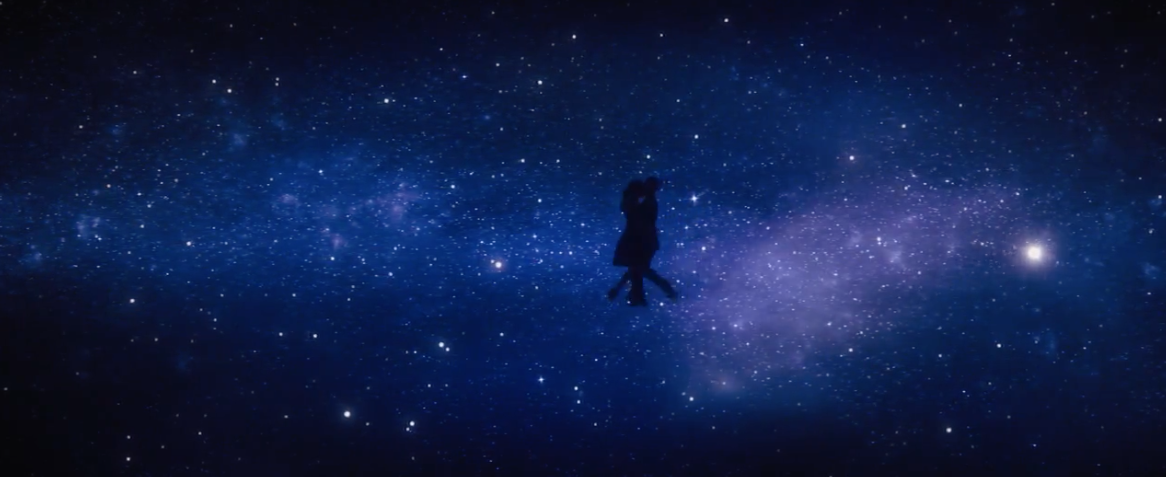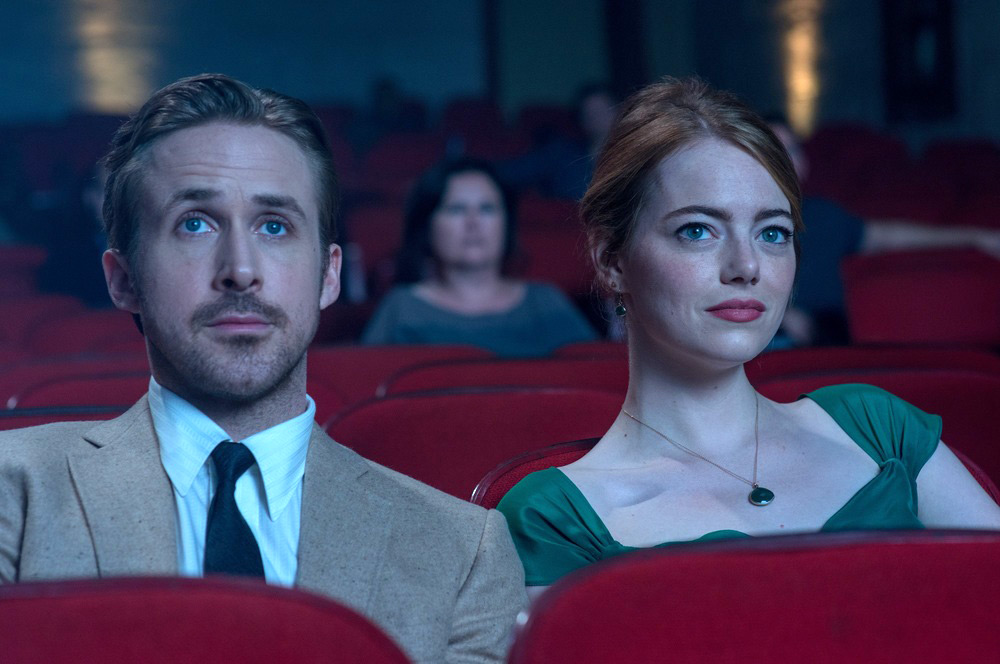Is there any genre that excites such undeserving scorn and hatred as the Musical? It seems that the very core of this hatred is nothing more than a revulsion to unceasing optimism and a complete refusal to suspend your disbelieve that normal people would burst out into song at random intervals.
I won’t say that La La Land solves this problem, nor that it is a problem. Indeed, it has a rather healthy dose of optimism that comes off, ultimately, as much more mature than any cynicism one might find in most TV or film nowadays. The very first scene in the movie is not just one person bursting into song, but a whole traffic jam’s worth of people bursting out into a perfectly choregraphed musical number—on Southern California freeways of all places (the real world would be more likely that they’d be shouting at each other to stop dancing on their cars).
Yes, Damien Chazelle, the film’s writer and director, accepts optimism and implausibility from the get-go as these drivers sing about how the sun always shines in California. Chazelle, being from the East Coast—from New Jersey, just like myself—plays with the East Coaster’s fetishization and idealization of California as a true ‘la la land’, as a paradise three thousand miles away, in-keeping with what Arthur Freed’s Technicolor musicals tell us.
In this fun and frolicking freeway, we are introduced, obliquely, to Mia (Emma Stone) and Sebastian (Ryan Gosling). They are both aspiring artists, she an actress working as an unfulfilled barista on a studio lot, he an unfulfilled jazz pianist forced to play kitschy Christmas tunes until he can make enough money to open his dream Jazz club.
This is a meet-cute in set-up, as all classic Hollywood musicals are. And yet, it takes its structure and its melancholic undertones from another musical-pastiche, Jacques Demy’s The Umbrellas of Cherbourg. They don’t find each other immediately, and as the film goes from Winter (in one of the funniest visual gags in the film, the word ‘Winter’ imposed over a picture of a sunny, warm-looking California) to Spring, to Summer, so on, there are separations, missed chances, etc.
Despite the extensively referential quality of Chazelle’s film—seemingly in-step with large swaths of contemporary culture, from the endlessly regurgitative qualities of social medias like tumblr and twitter where one may repost their favorite screenshots or gifs of films and television, to the nostalgic tones of Stranger Things, Netflix’s latest pop hit—Chazelle manages to establish himself as much more intelligent and knowing in his use of postmodern remaking.
While La La Land takes every opportunity it gets to throw in a reference—from pointing out the window used in Casablanca, to lighting a curtain with the same neon green hue from Vertigo—it never quite sacrifices the personal narrative in favor of sheer name-droppery.
The most spectacular sequence in the movie that demonstrates this (barring the end, which I won’t discuss as not to diminish the sheer aesthetic bliss that anyone watching the movie for the first time should experience) comes about halfway through the film, when Mia finally ditches her rich but boring and square boyfriend (what other kind is there when compared to Ryan Gosling?) in favor of seeing Rebel Without a Cause at an old movie theatre with Sebastian. Halfway through, the film burns up: right in the middle of the projection of the universe and its history in the observatory. Being in this la la land of LA, Mia and Seb decide to drive right up to the actual observatory itself, the Edward Griffith Observatory, where they walk right into the same room that sixty years ago was filled with James Dean, Natalie Wood, and Sal Mineo. It is here they share their first kiss, and Chazelle pulls what is probably one of the most intelligent intertextual twists that cinema has ever seen.
In Rebel, the original observatory sequence ends with the lecturer explaining how the universe with eventually implode in another big bang, and there will be nothing left. In La La Land, the film breaks down before he can explain that (bursting into its own apocalypse) and in finishing the sequence at the observatory, Chazelle in essence remakes the end of the scene. Rather than be a nihilistic apocalypse, he stages the blossoming of love among the stars as the film follows the tradition of The Red Shoes, Singin’ in the Rain, and An American in Paris in believing that dance need not stay among the ground, but may soar into the infinities of space. Our dancers swing through the stars—through the cosmos, invoking the expansiveness of our galaxy, the greatest Technicolor spectacle of all, and the ability for love to float transcendently among it all.

Where this film distinguishes itself from those films, and shows Chazelle as just as much a descendent of the personal filmmakers of the 1970s, is when he does stay among the ground. He is not afraid of staying in unwavering, solid close-ups in a fight between Mia and Seb, lacking any aesthetic flash (which he’s demonstrated amply throughout the film he’s capable of), instead favoring in this sharp contrast to the rest of the film the emotional intensity of his two lead actors. He reminds us why these two pretty faces are stars: they’re capable of emoting the most subtle of heartbreaks. We see in Emma Stone not the beautiful starlet of the red carpet, but these odd, strange eyes that suddenly stop seeming simply photogenic and instead become astonishingly aching.
As the film draws to a close, Chazelle’s accomplishment lies not in the examination of careers, as the last section of the film becomes increasingly concerned with the strain on the relationship between Mia and Sebastian as one finds success at a price while the other finds failure with integrity. The film never quite squares that problem, especially as Chazelle himself is performing what is essentially a personal project through the mode of a largely commercial venture (the pop and glamor of musicals). His accomplishment is in his range. One thing I’ve touched on very little throughout this review is the presence of Jazz in the film, but it is certainly integral to Chazelle’s work, as anyone who has seen Whiplash will know.He, as it were, plays all the notes: big, expansive scenes; small, intimate scenes; double exposures and bare compositions; dialogue and lyrics and silence; realism and fantasy.
Some may avoid La La Land because it’s a musical, because it’s not realistic, but the very intensity of its reality is only heightened through its fantastic expressionism. We understand more potently, more thoroughly their heartache, disappointment, and love because we see the dreamy landscape out of which this music and these dances are created.

beautiful analysis of the rebel without a cause scene.
Ontdek premium cannabisproducten bij Squnk Store. Wij bieden een breed assortiment van hoogwaardige Cali Weed, cannabissoorten en accessoires. Bestel online voor snelle en discrete levering in Nederland. Al onze producten worden streng getest op sterkte en zuiverheid voor de beste ervaring. Bezoek vandaag nog Squnk Store voor de beste cannabis.